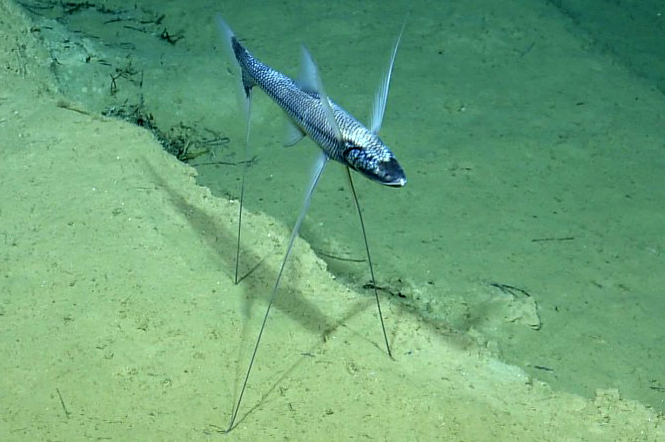Tripod Spiderfish, Bathypterois grallator (Goode & Bean 1886)
Other Names: Tripodfish

A Tripod Spiderfish, Bathypterois grallator, on Mona Slide in the Caribbean, depth 1996-2022 m. Source: Ocean Exploration Trust / WoRMS. License: CC By Attribution-NonCommercial-ShareAlike
Summary:
A spiderfish with extremely long caudal and pelvic-fin rays that are longer than the standard length of the fish, relatively short pectoral fins, and no adipose fin.
Tripod Spiderfish rest motionless on the abyssal plain on their extremely long pelvic and caudal fins. They face into the current, holding their long pectoral fins upright or forwards to sense prey items drifting by in the current.
Specialized pads on the tips of the pelvic and caudal fins allow the tripodfish to perch up off the soft sediment.
Video of a Tripod Spiderfish at a depth of 750 metres.
Tripod Spiderfish rest motionless on the abyssal plain on their extremely long pelvic and caudal fins. They face into the current, holding their long pectoral fins upright or forwards to sense prey items drifting by in the current.
Specialized pads on the tips of the pelvic and caudal fins allow the tripodfish to perch up off the soft sediment.
Video of a Tripod Spiderfish at a depth of 750 metres.
Cite this page as:
Bray, D.J. 2022, Bathypterois grallator in Fishes of Australia, accessed 10 Jul 2025, https://fishesofaustralia.net.au/Home/species/2779
Tripod Spiderfish, Bathypterois grallator (Goode & Bean 1886)
More Info
|
Distribution |
Off Northwest Cape, Western Australia, and off eastern Australia. Elsewhere, the species is widespread in the Indo-west-central-Pacific and Atlantic oceans. Inhabits the lower continental slope, continental rise, oceanic ridges and the abyssal plain. |
|
Features |
Gular fold scaled; 10-13 anal fin rays; 13-15 pectoral-fin rays (incl. rudiments), rays 3 and 4 closely applied but unfused, rays 5 through 9 never rudimentary; first pelvic-fin ray strengthened and greatly elongated (greater than 100% SL), second fin ray thin, half as long as the first, and closely applied to it; lower caudal-fin ray(s) greatly produced (38-134% SL); vomer with two large elliptical tooth patches; basibranchial 3-4 with dentigerous dermal plates; 34-37 rakers on the anterior gill arch; lateral-line scales 58-60; Vertebrae 53-54; . |
|
Colour |
Color uniform black. |
|
Feeding |
Their extremely long caudal and pelvic rays enables Tripod Spiderfish to "stand" up off the bottom. They often orientate their pectoral fins in an upright or forward position, which may be a sensory mechanism for detecting the movement of prey and feed mostly on benthopelagic organisms such as small crustaceans and gelatinous plankton drifting by in the current. |
|
Biology |
Spiderfishes (family Ipnopidae) are simultaneous hermaphrodites. Individuals have an ovotestis containing functional male and female reproductive tissue. |
|
Remarks |
Individuals prop tripod-like on their long pelvic and caudal fin rays, raising their bodies off the seafloor. They face into the current, extending their long sensory pectoral fins forward to detect the movement of zooplankton such as small crustaceans that drift by in the current. Underwater ROV images have shown the trails made when these fishes 'walk' over the seafloor on their pelvic fins and lower tail fin lobe. |
|
Etymology |
The specific name is from the Latin grallator (= one who walks on stilts), in reference to the habit of this species to raise their bodies off the seafloor by propping tripod-like on their long pelvic and caudal fin rays. |
|
Species Citation |
Benthosaurus grallator Goode & Bean, 1886, Bull. Mus. Comp. Zool. 12(5): 168. Type locality: Gulf of Mexico off northern Florida, 24°33'N, 84°23'W, depth 1850 fathoms; off New Jersey, USA, western North Atlantic, 39°03'15"N, 70°50'45"W, depth 1537 fathoms. |
|
Author |
Bray, D.J. 2022 |
|
Resources |
Tripod Spiderfish, Bathypterois grallator (Goode & Bean 1886)
References
Bannerman, P., Poss, S., Russell, B. & Nunoo, F. 2015. Bathypterois grallator. The IUCN Red List of Threatened Species 2015: e.T194992A15571915. http://dx.doi.org/10.2305/IUCN.UK.2015-4.RLTS.T194992A15571915.en. Downloaded on 27 May 2017.
Crabtree, R.E., Carter, H.J. & Musick, J.A. 1991. The comparative feeding ecology of temperate and tropical deep-sea fishes from the western North Atlantic. Deep-Sea Research 38:1277-1298. https://doi.org/10.1016/0198-0149(91)90027-D
Davis, M.P. & Chakrabarty, P. 2011. Tripodfish (Aulopiformes: Bathypterois) locomotion and landing behaviour from video observation at bathypelagic depths in the Campos Basin of Brazil. Marine Biology Research 7(3): 279-303 http://dx.doi.org/10.1080/17451000.2010.515231 Abstract
Gartner, J.V., Crabtree, R.E. & Sulak, K.J. 1997. Feeding at depth. Chapter 4, pp 115-193 in Randall DJ, Farrell AP (eds) Physiology of Deep-Sea Fishes, Vol. 16. San Diego, California: Academic Press.
Goode, G.B. & Bean, T.H. 1886. Reports on the results of dredging under the supervision of Alexander Agassiz, in the Gulf of Mexico (1877–78) and in the Caribbean Sea (1879–80), by the U.S. Coast Survey Steamer Blake, Lieut. Commander C.D. Sigsbee, U.S.N., and Commander J.R. Bartlett, U.S.N., commanding. 28. Description of thirteen species and two genera of fishes from the Blake collection. Bulletin of the Museum of Comparative Zoology, Harvard 12(5): 153-170. See ref at BHL
Jones, A.T. & Sulak, K.J. 1990. First central Pacific plate and Hawaiian record of the deep-sea tripod fish Bathypterois grallator (Pisces: Chlorophthalmidae). Pacific Science 44: 254-257. http://hdl.handle.net/10125/1281
Sulak, K.J. 1977. The systematics and biology of Bathypterois (Pisces: Chlorophthalmidae) with a revised classification of benthic myctophiform fishes. Galathea Report 14: 49-108. See ref online (pdf)
Williams, A., Last, P.R., Gomon, M.F. & Paxton, J.R. 1996. Species composition and checklist of the demersal ichthyofauna of the continental slope off Western Australia (20–35º). Records of the Western Australian Museum 18: 135-155.




